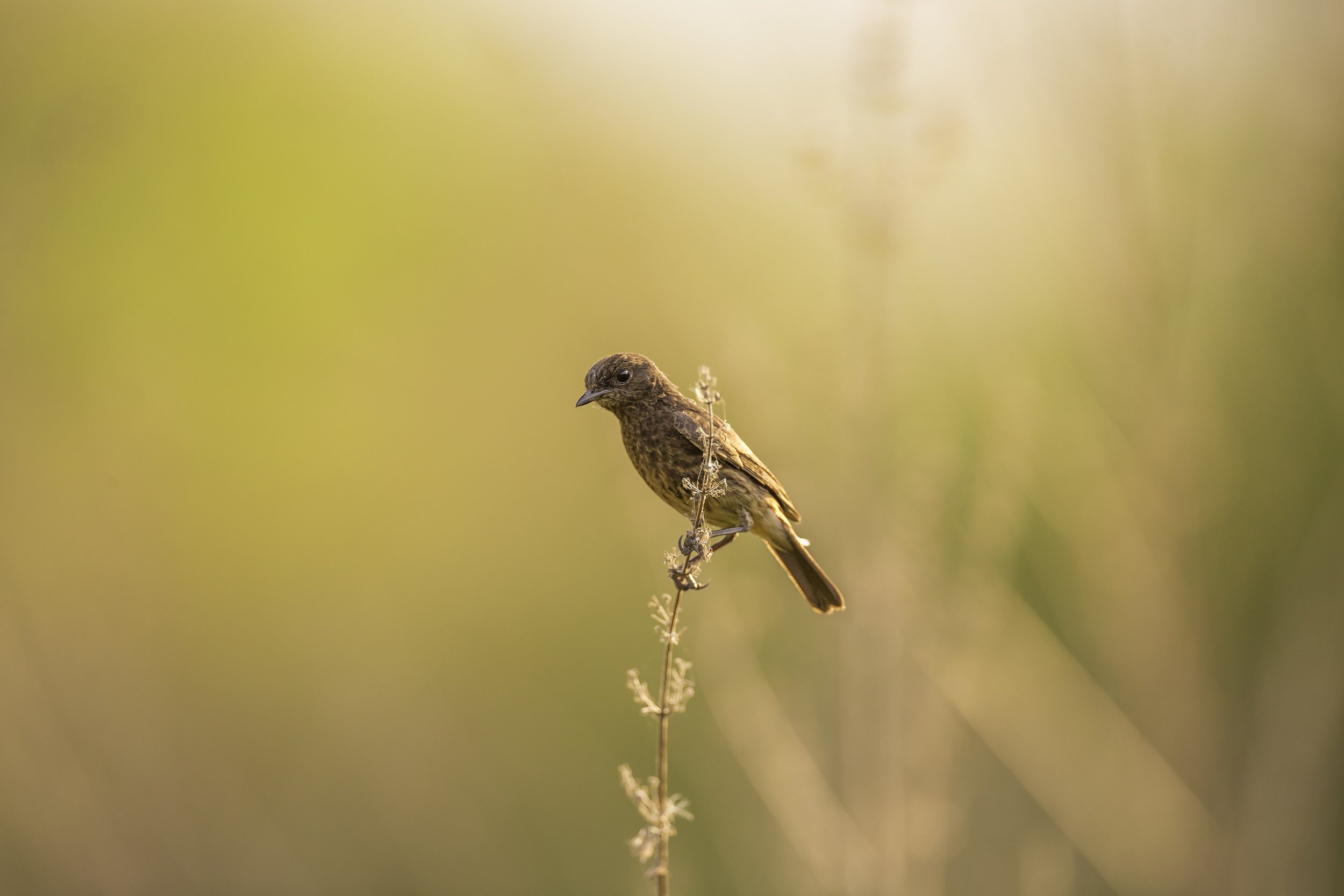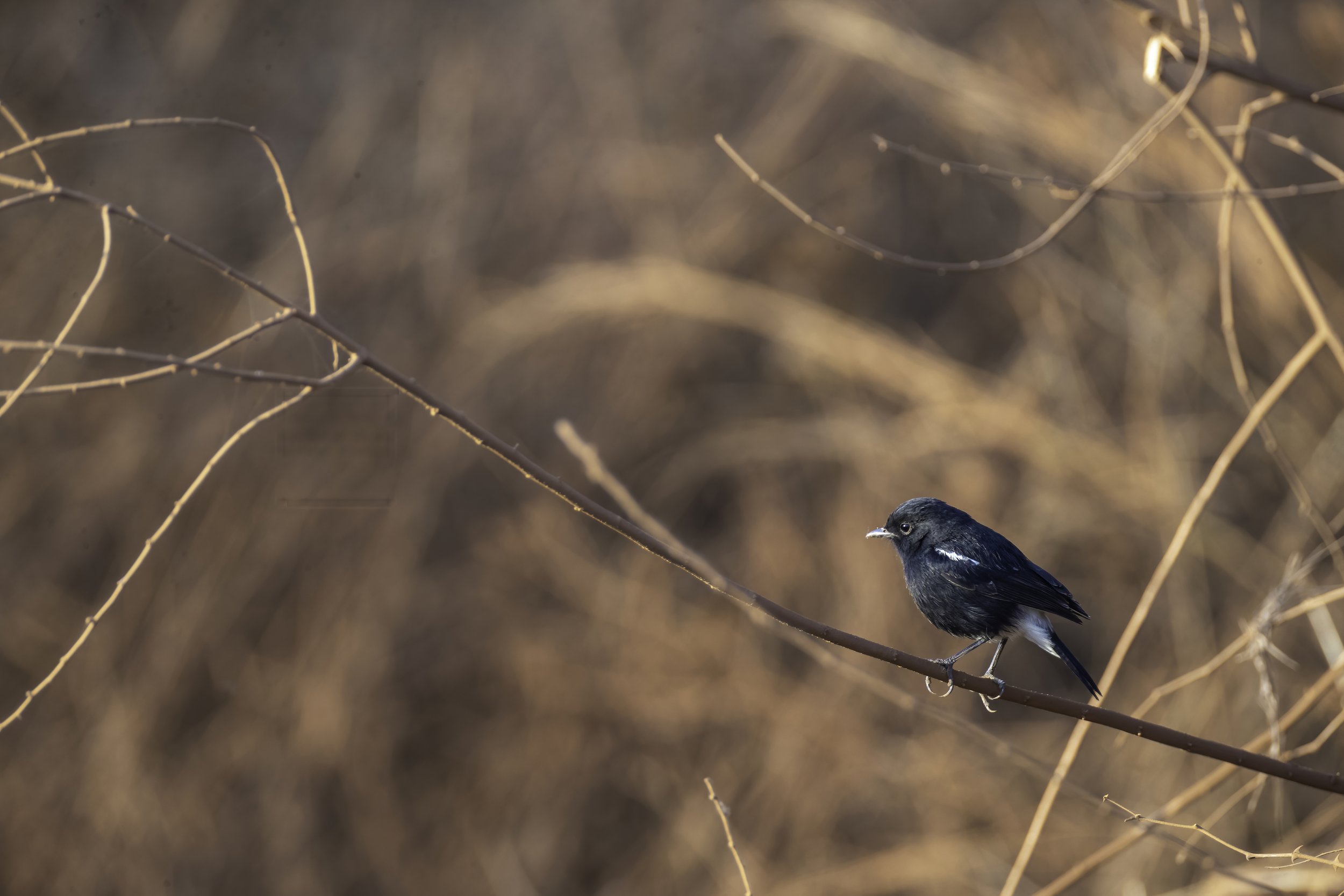Pied Bush Chat
Saxicola caprata
Yenkathala Grasslands
Telangana is the eleventh largest state in India situated on the south-central stretch of the Indian peninsula on the high Deccan Plateau. It is the twelfth-most populated state in India with a geographical area of 112,077 km² of which 21,214 km² is forest cover. The dry deciduous forests ecoregion of the central Deccan Plateau covers much of the state, including Hyderabad. The characteristic vegetation is woodlands of Hardwickia binata and Albizia amara. Over 80% of the original forest cover has been cleared for agriculture, timber harvesting, or cattle grazing, but large blocks of forest can be found in the Nagarjuna Sagar - Srisailam Tiger Reserve and elsewhere. The more humid Eastern Highlands moist deciduous forests cover the Eastern Ghats in the eastern part of the state. The Central Deccan forests have an upper canopy at 15–25 meters, and an understory at 10–15 meters, with little undergrowth.
The dry sub-humid zone or Dichanthium-cenchrus-lasitrrus type of grasslands are prevalent here and cover almost the entirety of peninsular India except the Nilgiris. One sees thorny bushes like the Acacia catechu or Khair as it is known in Hindi, Mimosa, Zizyphus (Ber) and sometimes the fleshy Euphorbia, along with low trees of Anogeissus letifolia or Axle Wood, Soymida febrifuga - the Indian Redwood - and other deciduous species. Sehima (grass) which is more prevalent on gravel is about 27% of the cover and Dichanthium (grass) which flourishes on level soil is almost 80% of the coverage.
Grasslands are natural carbon sinks and therefore crucial to the global carbon cycle due to their high rates of productivity, enhanced carbon sequestration rates and geographical extent keeping global temperatures more or less in balance. They are also breeding grounds for many migratory and endangered species like the Indian Grey Wolf of which only about 3,000 are left in the wild. It is a common response from people to think forests when green cover is mentioned but grasslands are of equal import. These open natural ecosystems urgently need attention and government initiatives for protection and conservation. In Telangana, grasslands are located in the districts of Vikarabad, Nizamabad, Khammam, Siddipet and Nalgonda. The wildlife in these fragile ecosystems today face numerous threats like hunting, spread of the canine distemper virus which affects foxes, wolves & several other species, rabies from feral dogs and most crucially, habitat loss.
The bird today - the Pied Bush Chat is from one such spectacular grasslands about 60 kilometres from the capital city of Hyderabad. These grasslands are home to as many as 191 bird species which include migrants like the Pallid & Montagu’s Harriers who winter here from Russia and Eastern Asian countries traveling over 5,000 kilometers. The rare Indian Grey Wolf has also been spotted here along with a number of foxes.
Read about these rare migrant harriers here.
The winter weather in Telangana is cold with a mild sun, especially now in January and as the sun rises these grasslands are bathed in a golden hue. The long stalks of grass sway dreamily in the cold, soaking up the sun and a peaceful silence reigns. Slowly the faint, but interminable chirping of birds permeates and breaks the silence with a not so strong wind unobtrusively rustling through the long grass. Butterflies start to flutter, dainty and somewhat ethereal, dragonflies & damselflies hover, fiercely red & floating with intent. These are the base of the pyramid that sustains the cycle of life on these grasslands.
Pied Bush Chat
The Pied Bush Chat (Saxicola caprata) is a small passerine bird found ranging from West Asia and Central Asia to the Indian subcontinent and Southeast Asia. About sixteen subspecies are recognized through its wide range with many island forms. It is a familiar bird of countryside and open scrub or grassland where it is found perched at the top of short thorn trees or other shrubs, looking out for insect prey. They pick up insects mainly from the ground, and were, like other chats, placed in the thrush family Turdidae, but are now considered as Old World flycatchers. A sedentary “chat”, the males are black with a white vent and a white wing patch while the females are dark brown with a reddish-brown rump and underparts. The females can resemble the migratory Siberian Stonechat, but can be separated by the absence of an eyebrow and of any white on the collar or wing. Rather conspicuous; it may use and sing from any open perch unlike more discerning stonechats.
They nest in cavities in stone walls or in holes in an embankment, lining the nest with grass and animal hair. The males are black with white shoulder and vent patches whose extent varies among populations. Females are predominantly brownish while juveniles are speckled.
At 13 cm, the pied bush chat is slightly smaller than the Siberian stonechat, although it has a similar dumpy structure and upright stance. The male is black except for a white rump, wing patch and lower belly. The iris is dark brown, the bill and legs black. The female is drab brown and slightly streaked. Juveniles have a scaly appearance on the underside but dark above like the females. The female has no white wing patches and the juveniles are similar to the females. The males display during the breeding season by splaying the tail, fluttering and puffing up the white scapular feathers
A number of geographic populations have been given subspecies status:
nominate caprata (Linnaeus, 1766) is found in Luzon and Mindoro, in the Philippines.
rossorum (Hartert, 1910) is found in NE Iran SC Kazakhstan S to Afghanistan and Baluchistan; migrant in SW Asia (vagrant in Arabia, Israel).(shows more white below than bicolor, described by Hartert, Jour. f. Orn. 1910:180 but not always recognised)
bicolour Sykes, 1832 is found in SE Iran, Afghanistan, Pakistan and N India; migrating to central India and possibly southern India.
burmanicus Stuart Baker, 1922 is found in peninsular India E to Myanmar and S China (S Sichuan, Yunnan), S to Thailand and Indochina. This has the white on the abdomen restricted towards the vent.
nilgiriensis Whistler, 1940 is found in the Western Ghats and the Nilgiri Hills.
atratus (Blyth, 1851) is restricted to Sri Lanka. This has a large bill.
Some of these isolated populations are found on islands and they include:
randi Parkes, 1960 found in the central Philippines (Panay, Negros, Cebu, Bohol, Siquijor).
anderseni Salomonsen, 1953 found on Leyte and Mindanao, in the Philippines.
fruticola Horsfield, 1821 found in Java E to Flores and Alor.
francki Rensch, 1931 is found on the Sumba Islands
pyrrhonotus (Vieillot, 1818) found in the E Lesser Sundas (Wetar, Kisar, Timor, Savu, Roti).
albonotatus (Stresemann, 1912) found in Sulawesi (except N peninsula) and Salayer I.
cognatus Mayr, 1944 on Babar Island.
belensis Rand, 1940 in WC New Guinea.
aethiops (P. L. Sclater, 1880) in N New Guinea and Bismarck Archipelago.
wahgiensis Mayr & Gilliard, 1951 in EC & E New Guinea.
Local names include Kala pidda in Hindi, Shyama in Gujarati, Kavda gapidda in Marathi, Kallu kuruvi in Tamil, Kampa nalanchi in Telugu. They were once popular in Bengal as cage birds. They are still found in the local bird trade of some parts of Southeast Asia.
Some populations are partially migratory and those in India appear to show seasonal movements but the patterns are unclear. Subspecies bicolor is found in peninsular India in winter. In Karwar on the western coast, it is said to appear in October and stay till May but not seen during the rainy season. Said to be absent in the Baroda district of Gujarat from April to September.
Among the Toda people in the Nilgiris, the pied bush chat is a bird of omen and the origin of its white wing patches is described in a story of a dairy priest who in the ritual of churning milk forgot to remove the churning stick before fetching water from a stream. The bird attempted to obstruct him by blocking his path but he disregarded it and flicked off butter from his hands. The white spots remained but the priest met his death. The Kotas of the Nilgiris have an origin story to explain the sexual dimorphism of the pied bushchat but they consider the "karyvaky" bird to be one that foretells good omen.
‡‡‡‡‡
Related Posts















